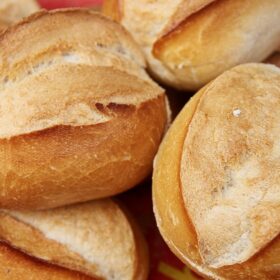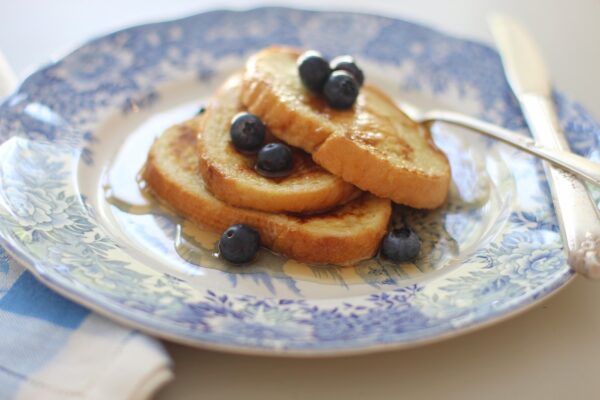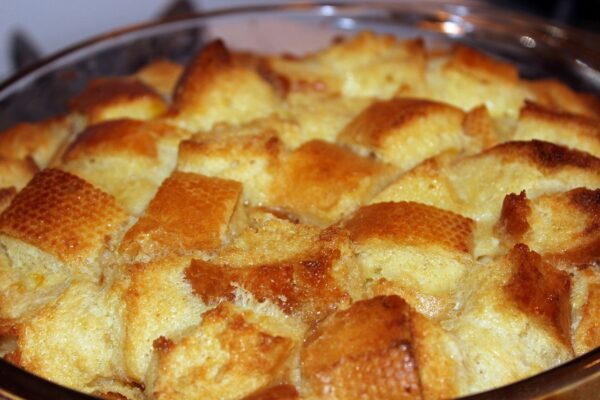
Making homemade bread can be a deeply satisfying and rewarding experience. Not only does it fill your home with the comforting aroma of fresh-baked goodness, but it also allows you to control the ingredients and create a healthier, tastier loaf than many store-bought options. This guide will walk you through a simple yet foolproof recipe for homemade bread, along with tips for achieving the best results, and answers to common questions about bread-making.
Ingredients
- 800g wheat flour
- 540g water
- 25g salt
- 7g dry yeast
Directions
- Combine Dry Ingredients:
- Place the wheat flour, dry yeast, and salt in a large mixing bowl. Mix well to evenly distribute the yeast and salt throughout the flour.
- Add Water:
- Pour in the water and mix until a rough dough forms. Ensure all the flour is hydrated and the mixture is uniform.
- First Rise:
- Cover the bowl with a clean cloth or plastic wrap and let the dough rest for 1 hour. This allows the yeast to begin fermenting, which helps the dough rise.
- Fold the Dough:
- After the first rise, press the dough slightly flat and then fold it over itself at least three times. This step helps develop the gluten structure, which is crucial for a good rise and texture.
- Prepare for Baking:
- Preheat your oven to 250°C (480°F). Place the dough in a preheated Dutch oven, cover it, and bake for 30 minutes. The Dutch oven traps steam, creating a perfect environment for the bread to rise and develop a crispy crust.
- Finish Baking:
- After 30 minutes, remove the lid from the Dutch oven and continue baking for an additional 20 minutes. This allows the bread to turn a beautiful golden brown and ensures it’s fully cooked inside.
- Cool the Bread:
- Once baked, remove the bread from the Dutch oven and let it cool on a wire rack for at least 1 hour before slicing. Cooling is essential as it helps set the crumb structure and makes slicing easier.
Nutrition Facts (Per Slice)
- Calories: 150 (approx.)
- Total Fat: 1g (1% DV)
- Saturated Fat: 0g (0% DV)
- Cholesterol: 0mg
- Sodium: 100mg (4% DV)
- Total Carbohydrate: 30g (10% DV)
- Dietary Fiber: 2g (8% DV)
- Total Sugars: 1g
- Protein: 5g
Frequently Asked Questions
1. What is the secret to making homemade bread?
The secret to making great homemade bread lies in three key areas: quality ingredients, proper fermentation, and temperature control. Using high-quality flour and fresh yeast ensures a good rise and flavor. Allowing the dough to ferment properly develops flavor and structure. Finally, baking at the right temperature ensures a good crust and a fully cooked interior.
2. Is it cheaper to make your own bread?
Yes, making your own bread is generally cheaper than buying it from the store. The basic ingredients (flour, water, yeast, and salt) are inexpensive, and homemade bread can be more cost-effective, especially if you bake regularly.
3. What are the 6 main ingredients in bread?
The six main ingredients in traditional bread are flour, water, yeast, salt, sugar, and fat. This recipe is a simpler version that focuses on the essential four: flour, water, yeast, and salt. Sugar and fat can be added for flavor and texture variations.
4. Is homemade bread healthier?
Homemade bread is often healthier than store-bought varieties because it contains no preservatives, artificial additives, or excessive sugars and fats. You can also use whole grain flours and other nutritious ingredients to boost its health benefits.
Tips for Perfect Homemade Bread
1. Use Fresh Yeast:
- Fresh yeast ensures a good rise and better flavor. Check the expiration date on your yeast packet before using it.
2. Hydrate the Dough Properly:
- Make sure all the flour is hydrated when mixing the dough. This helps in the development of gluten, which is essential for the bread’s structure.
3. Fermentation Time:
- Allow the dough to ferment for the recommended time. This develops the flavors and ensures the bread rises properly.
4. Proper Folding:
- Folding the dough during the first rise helps to develop the gluten structure, which is crucial for the bread’s texture.
5. Preheat the Dutch Oven:
- Preheating the Dutch oven ensures a good crust. The steam trapped inside the Dutch oven helps the bread to rise and develop a crispy crust.
6. Cooling the Bread:
- Allow the bread to cool completely before slicing. This helps to set the crumb and makes slicing easier.

Homemade Bread
Ingredients
- 800 g wheat flour
- 540 g water
- 25 g salt
- 7 g dry yeast
Instructions
- Combine Dry Ingredients:
- Place the wheat flour, dry yeast, and salt in a large mixing bowl. Mix well to evenly distribute the yeast and salt throughout the flour.
- Add Water:
- Pour in the water and mix until a rough dough forms. Ensure all the flour is hydrated and the mixture is uniform.
- First Rise:
- Cover the bowl with a clean cloth or plastic wrap and let the dough rest for 1 hour. This allows the yeast to begin fermenting, which helps the dough rise.
- Fold the Dough:
- After the first rise, press the dough slightly flat and then fold it over itself at least three times. This step helps develop the gluten structure, which is crucial for a good rise and texture.
- Prepare for Baking:
- Preheat your oven to 250°C (480°F). Place the dough in a preheated Dutch oven, cover it, and bake for 30 minutes. The Dutch oven traps steam, creating a perfect environment for the bread to rise and develop a crispy crust.
- Finish Baking:
- After 30 minutes, remove the lid from the Dutch oven and continue baking for an additional 20 minutes. This allows the bread to turn a beautiful golden brown and ensures it’s fully cooked inside.
- Cool the Bread:
- Once baked, remove the bread from the Dutch oven and let it cool on a wire rack for at least 1 hour before slicing. Cooling is essential as it helps set the crumb structure and makes slicing easier.
Notes
Calories: 150 (approx.)
Total Fat: 1g (1% DV)
Saturated Fat: 0g (0% DV)
Cholesterol: 0mg
Sodium: 100mg (4% DV)
Total Carbohydrate: 30g (10% DV)
Dietary Fiber: 2g (8% DV)
Total Sugars: 1g
Protein: 5g
Variations and Serving Suggestions
1. Homemade Bread Recipes with Yeast:
- Experiment with different types of yeast for varied flavors and textures. Instant yeast can make the process quicker, while sourdough starter can add a tangy flavor.
2. Best Homemade Bread Recipe:
- Try adding seeds, nuts, or dried fruits to the dough for added flavor and texture. You can also use different types of flour like whole wheat or spelt.
3. Simple Bread Recipe:
- For a quicker recipe, reduce the fermentation time and use warm water to speed up the yeast activity.
4. How to Make Homemade Bread Light and Fluffy:
- Ensure the dough is well-kneaded to develop the gluten structure. Using a bit of sugar or honey can also help in achieving a lighter texture.
5. Different Types of Bread Recipes:
- Explore recipes for baguettes, ciabatta, focaccia, or brioche to expand your bread-making skills.
6. Bread Recipe with Instant Yeast:
- Instant yeast can be added directly to the flour without proofing, making the process faster and more convenient.
7. How to Make Bread Step by Step:
- Follow each step carefully, ensuring you measure ingredients accurately and allow adequate time for each process.
8. Artisan Bread Recipe:
- Use high-quality flour, a long fermentation time, and a hot baking environment to create artisan-style bread with a chewy crust and open crumb.
9. Homemade Bread Without Yeast:
- Try making quick breads or soda breads that use baking soda or baking powder as a leavening agent instead of yeast.
10. Homemade French Bread:
- French bread recipes typically involve a long, slow fermentation process and a high baking temperature to achieve a crispy crust and airy crumb.
Conclusion
Making homemade bread is a rewarding experience that offers delicious results. With this simple recipe and the tips provided, you can create a beautiful loaf of bread that rivals any bakery. Experiment with different variations and enjoy the wholesome goodness of homemade bread. Happy baking!


